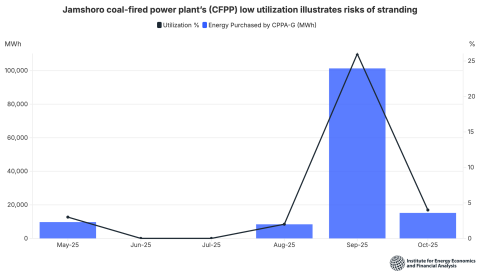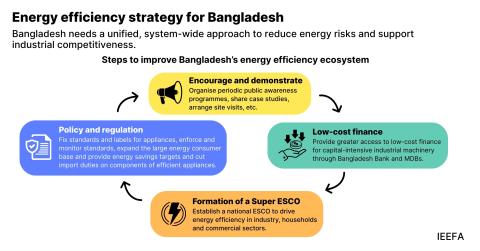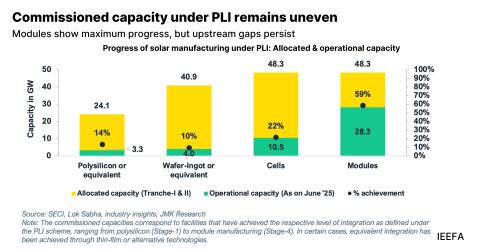Just Transition financing ecosystem: Stakeholder consultation report
Download Full Report
View Press Release

Key Findings
As climate commitments in India are accelerating, the energy transition must also be just—meaning that the shift away from fossil fuels should be inclusive, equitable, and supportive of workers and communities dependent on carbon-intensive sectors like coal, steel, cement, and automotive.
The Just Transition (JT) financing ecosystem involves coordination across regulators, ministries, financial institutions, corporates, and civil society, each playing interlinked and critical roles.
While sustainable finance in India is evolving, there is a significant gap in funding for social priorities such as worker reskilling, community resilience, and regional economic diversification.
Institutions like the Securities and Exchange Board of India and the Reserve Bank of India can support JT by integrating JT metrics into disclosures, lending norms, and sustainable finance tools like Priority Sector Lending and Sustainability Linked Loans.
Executive Summary
India is at a defining moment in its journey towards a low-carbon economy. As climate commitments are accelerating, the transition must also be just—meaning that the shift away from fossil fuels should be inclusive, equitable, and supportive of workers and communities dependent on carbon-intensive sectors like coal, steel, cement, and automotives. Ensuring a Just Transition (JT) is particularly important in coal-producing states like Jharkhand, Odisha, and Chhattisgarh, where the economy and livelihoods are deeply intertwined with fossil fuel-based industries.
A robust and inclusive financing ecosystem is essential to manage transition risks and unlock opportunities. India has made progress in sustainable finance. However, financing for the social dimensions of transition—such as worker reskilling, community resilience, and regional diversification—remains limited. This report explores how India can design a JT financing ecosystem that blends environmental ambition with socio-economic inclusion.
Mapping the Just Transition Financing Ecosystem
The JT financing ecosystem involves a wide array of stakeholders, including government ministries, regulators, financial institutions, corporates, and civil society. The roles of these stakeholders are interlinked. Regulatory institutions such as the Reserve Bank of India (RBI) and Securities and Exchange Board of India (SEBI) play a key role in aligning financial flows with sustainability goals, while policy institutions like the Ministry of Finance (MoF), Ministry of Environment, Forest and Climate Change (MoEFCC), and NITI Aayog provide the strategic and fiscal frameworks for transition.
Capital flows can be mobilised through public and private finance, including banks, non-banking financial companies (NBFCs), multilateral development banks (MDBs), and impact investors. Ministries can further influence investment direction through blended finance instruments and incentive structures. Corporates and their supply chains are also critical for implementation, particularly in high-emission sectors.
To understand these interlinkages, we conducted a stakeholder mapping exercise using an Interest-Influence Matrix. Key players such as RBI, SEBI, MoF, and state governments have both high influence and high interest in advancing a JT. Potential allies, including banks and ministries like coal or micro, small, and medium-sized enterprises (MSMEs), hold financial power but currently have limited engagement. Meanwhile, civil society and think tanks act as critical supporters, advocating for inclusion and equity.
Insights from Stakeholder Consultations
We conducted structured consultations, as well as a high-level roundtable with diverse stakeholders, including regulators, government agencies, and corporates, to map ongoing and planned JT initiatives. These engagements identified key enablers, challenges, and collaboration opportunities to strengthen India’s JT financing ecosystem and inform actionable recommendations.
Securities and Exchange Board of India (SEBI)
SEBI has laid a foundation for integrating sustainability into corporate disclosures through frameworks like the Business Responsibility and Sustainability Reporting (BRSR) and environmental, social, and governance (ESG)-linked financial products. However, there is currently no mandate to report on JT indicators. Expanding the BRSR to incorporate social risk and JT disclosures could help direct capital to companies with credible transition strategies.
Reserve Bank of India (RBI)
RBI, through its Sustainable Finance Group, has advanced climate risk management but does not recognise JT as a material financial risk. However, tools like Priority Sector Lending (PSL), sustainability-linked loans (SLLs), and green deposits could be adapted to support JT-aligned investments in vulnerable regions. Assessing the financial risk of stranded assets and socio-economic disruptions could further strengthen RBI’s regulatory approach.
Ministry of Finance (MoF)
The MoF plays a pivotal role in embedding JT into India’s economic and fiscal architecture. It can integrate JT principles into national green taxonomies, allocate budgetary resources, and establish a dedicated JT Fund to support affected regions and communities.
Ministry of Environment, Forest and Climate Change (MoEFCC)
The MoEFCC can ensure that a JT is aligned with climate and environmental policies. It can leverage initiatives like the Green Skill Development Programme and Green Credit Programme, as well as tap into international funds, such as the Green Climate Fund, to advance workforce transitions, nature-based solutions, and community resilience in fossil fuel-dependent regions.
Corporates
Corporates are gradually integrating JT considerations into business planning. However, high transition costs, limited access to finance for MSMEs, and supply chain constraints remain key barriers. Companies expressed the need for clearer policy guidance, supportive regulations, and structured engagement with investors. There is a growing demand to embed social inclusion metrics in ESG frameworks and incentivise green innovation.
Strategic Roadmap for Advancing Just Transition Financing
The following roadmap outlines actions across stakeholder groups over short-, medium-, and long-term horizons. It offers a phased strategy to integrate JT principles into India’s finance and policy architecture:

Way Forward
India’s transition to a net-zero economy must be a just and inclusive one. This report provides a strategic framework for embedding social equity into the financial architecture guiding the energy transition. Early regulatory integration, such as JT metrics in disclosures and lending norms, can lay the groundwork for long-term structural change.
Ultimately, a successful JT will require sustained coordination between ministries, regulators, state governments, corporates, and civil society. Investing in capacity building, financial innovation, and inclusive planning will ensure that India’s energy transition not only mitigates climate risk but also empowers its people and regions for a more equitable future.

















